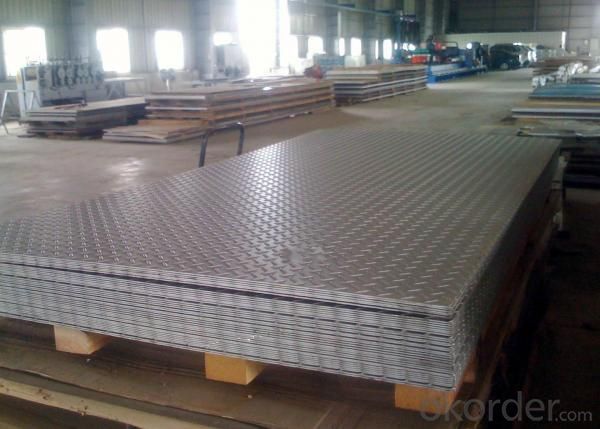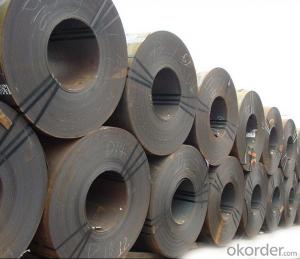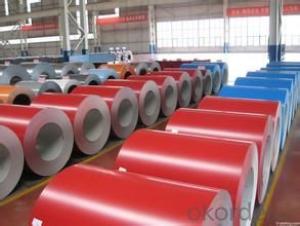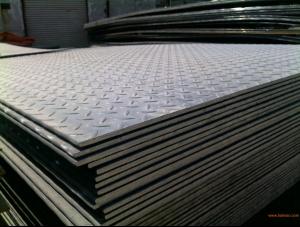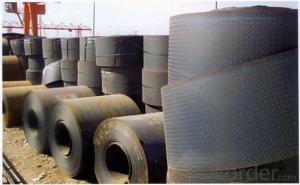High Quality Hot Rolled Checkered Sheet
- Loading Port:
- Xingang Port
- Payment Terms:
- TT or LC
- Min Order Qty:
- 100MT m.t.
- Supply Capability:
- 10000MT/Year m.t./month
OKorder Service Pledge
OKorder Financial Service
You Might Also Like
Specification of High Quality Hot Rolled Checkered Sheet:
1.Advantages of our High Quality Hot Rolled Checkered Sheet:
Our production capacity is extremly high, just as we take every details in producing and processing under strict control. For example, we have very high final rolling temperature, and meanwhile, the frizzling temperature must be kept suitable, so that the pattern cannot be made collapsed. That’s the reasons for our checkered sheet of high quality. The advantages of our checkered sheet could be read:
a) The unfairness of our checkered sheet: ≤10mm/mtr
b) The surface of our hot rolled checkered dimond plate is free from bubble, scab, crack, fold, edge delamination and so on.
c) The height of our hot rolled dimond plate will be maintained between 0.2~0.3 times to thickness of steel substrate, but more than 0.5mm at least.
2. Other details of High Quality Hot Rolled Checkereed Sheet(Q 345 C as example)
Standard | GB T 3277 |
Grade | Q345 C |
Thickness | 2.5-8.0mm |
Width | 1000-1600mm |
Length | 4000-8000mm |
Note: Dimension of our high quality hot rolled checkered sheet can be made according to your requirements, we can futher discuss about it.
3. The regular sections we provide are shown in the below table:
Base Thickness(MM) | Allowed Tolerance of Base Thickness(%) | Theoretical Mass (KG/M²) | ||
The Pattern | ||||
Rhombus | Beam | Pea | ||
2.5 | ±0.3 | 21.6 | 21.3 | 21.1 |
3.0 | ±0.3 | 25.6 | 24.4 | 24.3 |
3.5 | ±0.3 | 29.5 | 28.4 | 28.3 |
4.0 | ±0.4 | 33.4 | 32.4 | 32.3 |
4.5 | ±0.4 | 37.3 | 36.4 | 36.2 |
5.0 | 0.4~-0.5 | 42.3 | 40.5 | 40.2 |
5.5 | 0.4~-0.5 | 46.2 | 44.3 | 44.1 |
6.0 | 0.5~-0.6 | 50.1 | 48.4 | 48.1 |
7.0 | 0.6~-0.7 | 59.0 | 52.5 | 52.4 |
8.0 | 0.7~-0.8 | 66.8 | 56.4 | 56.2 |
4. Chemical Composition of High Quality Hot Rolled Checkered Sheet:
Grade | Chemical Composition | ||||
Q345C | C | Si | Mn | P | S |
≤0.20 | ≤0.55 | 1.00-1.60 | ≤0.035 | ≤0.035 | |
Note: Here, Q345C as example. We are also able to provide SGS test report for checkered sheet as per other material grade.
Applications of High Quality Hot Rolled Checkered Sheet:
1.Definition: The hot rolled checkered sheet with raised pattern on surface. The raised pattern could be shaped as rhombus,bean or pea. There is not only one kind of pattern on the checkered sheet, but also a complex of two or more than two kinds of pattern on surface of one checkered sheet. It also could be called as grid steel sheet.
2.Character: The Hot Rolled Checkered Sheet possesses a variet of advantages, such as beauty in appearance, skip resistance and saving steel material.Generally speaking,in order to test the mechanical property or the quality of hot rolled checkered sheet, the shaping rate and the pattern height should be tested primarily.
3. In conclusion, the hot rolled checkered sheet can usually be used in the industry of ship-building,boiler,automobil,tractor,train- building and architecture. In details, there are many demands for hot rolled checkered sheet to make floor,ladder at workshop,work frame pedal,ship deck,car floor and so on.
Package & Delivery of High Quality Hot Rolled Checkered Sheet:
1. The items to be prepared for packing include: narrow steel strip, crude steel belt or edge angle steel, kraft paper or galvanized sheet.
2. The high quality hot rolled checkered sheet should be wrapped with kraft paper or galvanized sheet ouside, and it should be bundled with narrow steel strip, three or two narrow steel strip in longitudinal direction,and the other three or two strips in transverse direction. Furthermore, in order to fix the hot rolled checkered steel plate and avoid the strip at edge shall be broken, the crude steel belt cut into square should be put under the narrow steel strip on the edge. Of course, the hot rolled checkered steel plate could be bundled without kraft paper or galvanized sheet. It depends on customer’s requirement.
3. In consideration of the transportaion from mill to loading port, the truck will be usually used. And the maximum quantity for each truck is 40mt.
4. All in all, we could do in accordance with customer's request.
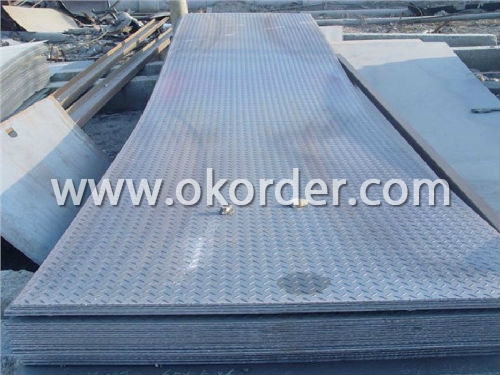
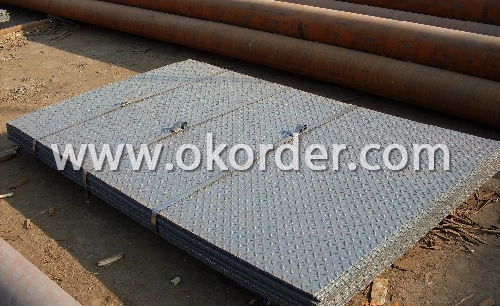
- Q: How to choose welding method for welding different plate and thick steel plate?
- Plate groove, the groove thickness is less than or equal to the thickness of the sheet, the welding arc to a plate, the molten pool of molten iron melt sheet, the specific point of view of plate thickness difference, observe the molten pool adjust current, prevent sheet welding, double-sided welding when necessary.
- Q: How do steel sheets compare to other materials like aluminum or plastic?
- Steel sheets are generally stronger and more durable compared to aluminum or plastic sheets. They have a higher tensile strength and can withstand heavier loads. However, steel sheets are heavier and may require additional support structures. Aluminum sheets are lightweight and have good corrosion resistance but are not as strong as steel. Plastic sheets are lightweight and inexpensive, but they lack the strength and durability of steel or aluminum. Ultimately, the choice between steel, aluminum, or plastic sheets depends on the specific application and requirements.
- Q: Can steel sheets be used for window frames?
- Yes, steel sheets can be used for window frames.
- Q: Are steel sheets resistant to graffiti?
- Yes, steel sheets are generally resistant to graffiti due to their smooth and non-porous surface, making it difficult for spray paint or other graffiti materials to adhere. Additionally, steel sheets can be easily cleaned or repainted if graffiti does occur.
- Q: Are steel sheets versatile in terms of design and customization?
- Yes, steel sheets are highly versatile in terms of design and customization. They can be easily manipulated into various shapes, sizes, and patterns to suit a wide range of applications. Additionally, steel sheets can be painted, coated, or textured to achieve specific aesthetic and functional requirements, making them an excellent choice for designers and architects.
- Q: What are the different bending radius options for steel sheets?
- The bending radius options for steel sheets can vary depending on the thickness and type of steel being used. However, common bending radius options for steel sheets typically range from 0.5 times the thickness of the sheet to 2 times the thickness of the sheet.
- Q: Can the steel sheets be painted or coated?
- Yes, steel sheets can be painted or coated.
- Q: How do steel sheets perform in terms of thermal insulation?
- Steel sheets do not perform well in terms of thermal insulation as they conduct heat efficiently due to their high thermal conductivity.
- Q: Are steel sheets suitable for elevator shafts or cabin interiors?
- Yes, steel sheets are suitable for elevator shafts and cabin interiors. Steel is commonly used in the construction of elevator shafts due to its strength, durability, and fire resistance properties. It is also an ideal material for cabin interiors as it can be easily customized, provides a sleek and modern appearance, and can withstand heavy use and wear.
- Q: What are the different types of steel sheet finishes?
- There are several different types of steel sheet finishes that serve various purposes and provide different aesthetics. Some of the common types include: 1. Hot Rolled: This finish is achieved by heating the steel sheet above its recrystallization temperature and then rolling it to the desired thickness. It has a rough and textured surface, making it suitable for applications where appearance is not a priority. 2. Cold Rolled: After the hot rolling process, the steel sheet is passed through rollers at room temperature to achieve a smooth and polished finish. Cold rolled finishes are often used in applications that require a superior surface finish, such as automotive panels or appliances. 3. Galvanized: In this process, the steel sheet is coated with a layer of zinc to provide corrosion resistance. The zinc coating also gives the sheet a shiny and reflective appearance. Galvanized finishes are commonly used in outdoor applications to protect against rust and harsh weather conditions. 4. Stainless Steel: This finish is achieved by adding chromium to the steel sheet, which provides excellent corrosion resistance and a sleek, reflective surface. Stainless steel finishes are widely used in kitchen appliances, architectural applications, and medical equipment, where hygiene and durability are essential. 5. Coated Finishes: Steel sheets can be coated with various materials, such as paint, epoxy, or polymer, to enhance their appearance or provide additional protection. Coated finishes can be customized to meet specific requirements, such as color or texture, and are often used in architectural and decorative applications. 6. Brushed: This finish is obtained by brushing the steel sheet with abrasive material, creating a textured and matte surface. Brushed finishes are commonly used in interior design and furniture manufacturing, where a contemporary and stylish appearance is desired. These are just a few examples of the different types of steel sheet finishes available. The choice of finish depends on the specific requirements of the application, such as corrosion resistance, aesthetic appeal, or surface texture.
1. Manufacturer Overview
| Location | Tianjin, China |
| Year Established | 2004 |
| Annual Output Value | Above US$ 500 Million |
| Main Markets | China; Europe; America; Southeast Asia |
| Company Certifications | ISO9001、ISO14001、OHSAS18001 |
2. Manufacturer Certificates
| a) Certification Name | |
| Range | |
| Reference | |
| Validity Period |
3. Manufacturer Capability
| a) Trade Capacity | |
| Nearest Port | Tianjin; Qingdao; Dalian |
| Export Percentage | 41% - 50% |
| No.of Employees in Trade Department | 21-50 People |
| Language Spoken: | English; Chinese |
| b) Factory Information | |
| Factory Size: | Above 900,000 square meters |
| No. of Production Lines | 3 |
| Contract Manufacturing | OEM Service Offered |
| Product Price Range | High; Average |
Send your message to us
High Quality Hot Rolled Checkered Sheet
- Loading Port:
- Xingang Port
- Payment Terms:
- TT or LC
- Min Order Qty:
- 100MT m.t.
- Supply Capability:
- 10000MT/Year m.t./month
OKorder Service Pledge
OKorder Financial Service
Similar products
Hot products
Hot Searches
Related keywords





